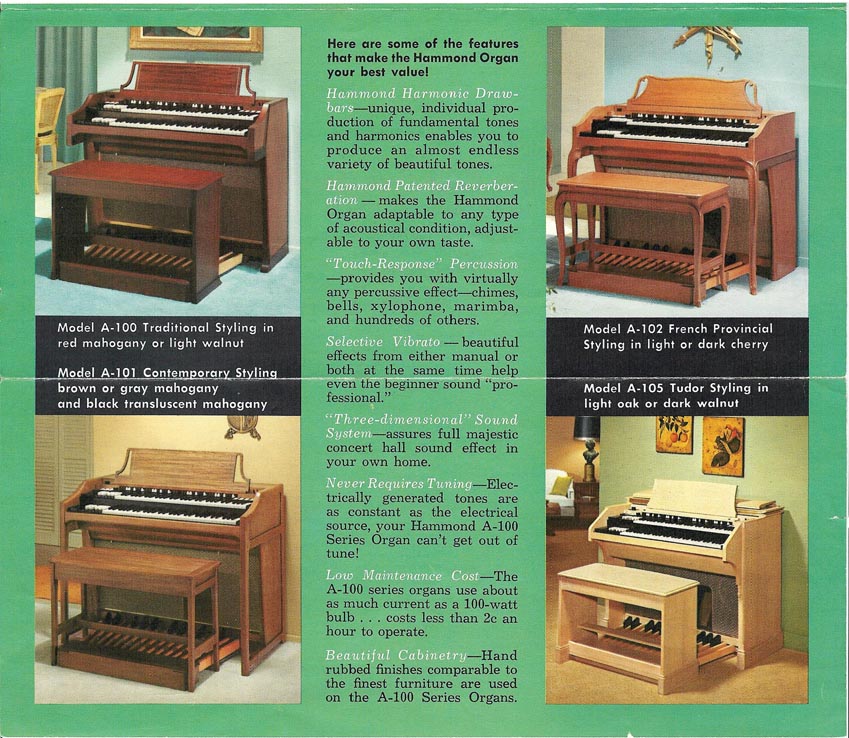
A-100 - best in its class
"The best B-3's are A-100's" - now what does this statement mean? It
points to the fact that a Hammond A-100 organ is in fact the exact same
organ as the legendary B-3, and then some. As many may know, the A-100 is
the home version of the B-3/C-3 organs. The cabinets of the A-100 models
were all, with one exception, tailored for home use: No locking top,
built-in speakers and reverb, and a wider selection of wood finishes and
stylings. Today, the A-100 series organs have become increasingly sought
after because they are generally well kept and less played than B/C-3 organs
previously owned by churches or professional musicians. Also, the slimmer
profile of the A-100 cabinet (especially the 'plain Jane' A-100 model) is
prefered over the B-style cabinet for taking on the road.
A quick history review
The first A-100 organs were produced in 1959. They had the
necklace type reverb as found in contemporary Hammond Tone Cabinets. The
A-100 was the first tonewheel console with built-in reverb. In the early
60's a few more models of the A-100 theme were issued, the French Provincial
A-102 and the spiffy 'Contemporary' A-101. Also, the C-3 cabinet was adapted
to contain the A-100 speaker system, creating model A-105 (complete with a
locking top). In late 1964 the last
two models, the A-122 in Patina Walnut and the the Early American
A-143, were issued and in 1965 the A-100 series was
discontinued. However, the A-105 remained in production until the very last
tonewheel organs were made in the mid 70's. Since the A-105 was still around
after 1965, the special parts needed to make it - i.e. the speakers,
power amplifier etc. - were too, so regular A-100 organs were actually being
produced well into the 70's in the U.K., Belgium and Germany.
| Model | Design name | Finishes available | Features |
| A-100 | Traditional | Red mahogany, light walnut | First model to be introduced in 1959. First version had the 'necklace' type reverb |
| A-101 | Contemporary | Grey mahogany, brown mahogany, translucent black | Leslie models 51 and later 251 could be ordered to match the finish of your A-100 organ |
| A-102 | French Provincial | Light and dark cherry | Not recommended for road or church use because of the relatively fragile, thin, sculptured legs |
| A-105 | Tudor | Light oak, dark walnut | C-style 'church' cabinet with locking top, very similar to C-3. In production until 1975 |
| A-122 | Contemporary | Patina walnut | A slightly altered version of A-101, only produced for a short period in 1964/65 |
| A-143 | Early American | Maple | This model and model A-122 are the rarest A-100 versions |
Below is a nice brochure from the early 60's, kindly scanned by Don Resor Jr. of California, U.S.A.





A wonderful A-100 in rosewood. This one was custom made by Hammond Organ Co. in the UK in the 1960s. Picture kindly supplied by Bevis Peters, United Kingdom.
Connecting a Leslie speaker to A-100 organs
There were a few options available when it came to connecting an A-100 organ to a Leslie speaker. Because the organ had its own dual channel sound system, the console could be regarded as a self contained organ with two output channels (main and reverb) or a single channel organ with a separate tone cabinet built into the lower part of the cabinet. Depending on the setting and/or application of the organ, four basic setups could be used:
| Hook-up type | Leslie model(s)* | Leslie kit # | Features | Pros | Cons |
| Single channel, Hammond | 122, 22H | 8101 | Connects directly to the preamp | Exactly the same sound as a B-3, compatible with Hammond tone cabs | No reverb in the Leslie |
| Dual channel, Conn | 251, 351 | 8253 | Reverb is routed to a separate stationary channel | Fullest reproduction of the A-100 reverb sound | Somewhat non-standard hookup |
| Single channel, universal | 147, 145, (760) | 7271 (9510) |
Only main channel is sent to Leslie (from power amp) | Simple connection, no non-standard components needed | The A-100 power amp has a bass-boost circuit to help the pedal notes through the internal speakers. This bass boost may be undesirable in the Leslie signal. |
| Dual channel mixed, universal | 8444** | Main and reverb channels are mixed together and sent to Leslie | Reverb is available in the Leslie | Reverb is 'spun around' |
**Kit # 8444 is for speaker models 147/145/125 (and compatible). There was no Leslie kit for connecting both channels of an A-100 to a 9-pin Leslie such as model 760
More details on how to connect Leslies to an A-100 are availabe in the Leslie 122, 147 and 251 manuals that you can download here

Above is a model A-122 with a Leslie 22H and 31H. Picture kindly donated by Peter Abrams in Florida, USA.
Below is an A-143. Picture supplied by George Fish of Fish Organs in San Diego, California, USA.
